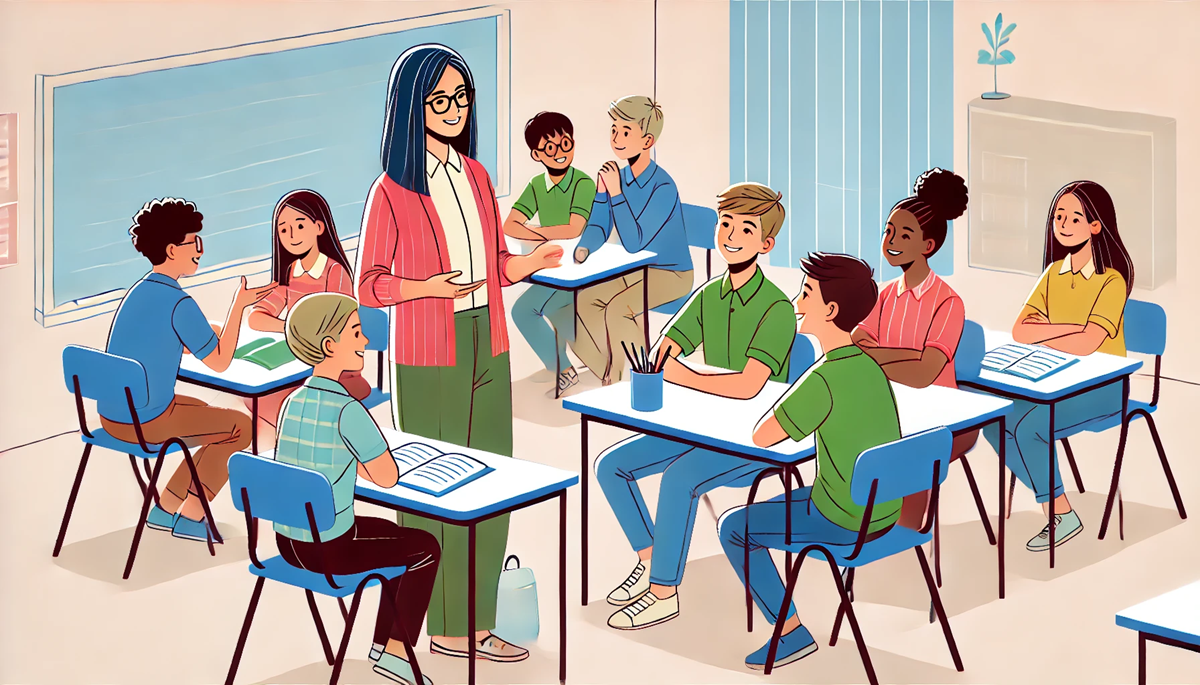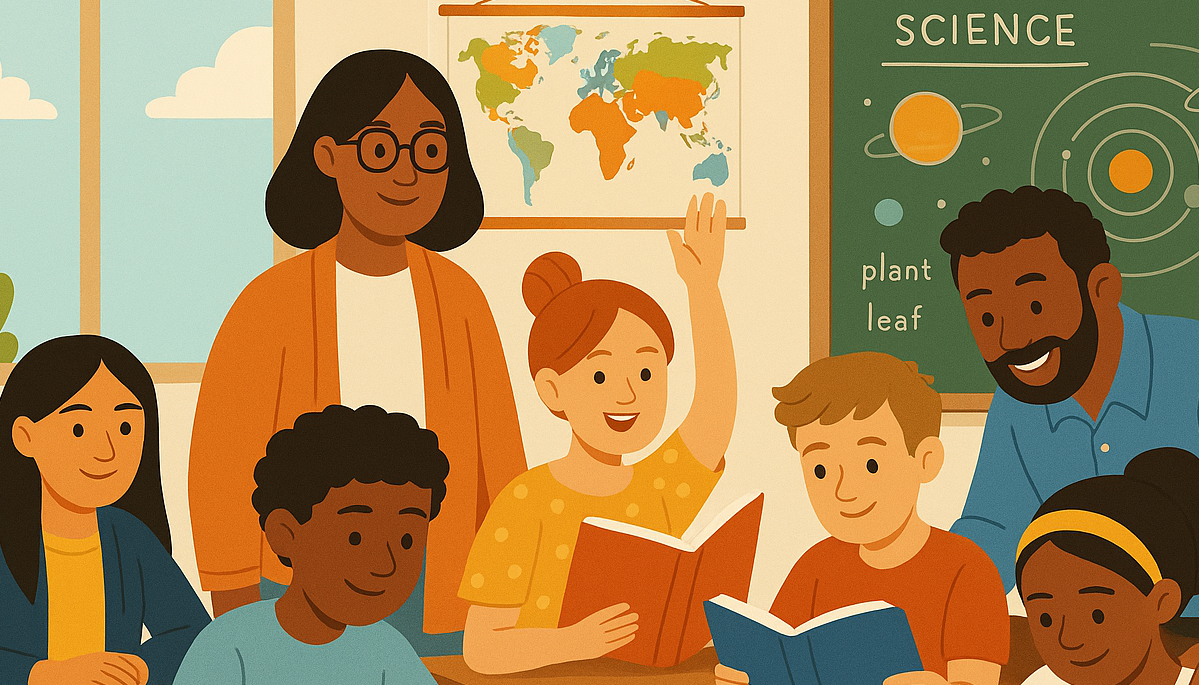Imagine arriving in a foreign country where you don’t speak the language.
Everything sounds different, and you struggle to communicate even the simplest needs.
This is what it feels like for students learning a second language.
At Ensemble Learning, we’ve spent years helping schools guide these students through the stages of second language acquisition (SLA).
We’ve seen firsthand the incredible progress that can be made with the right support.
In this article, we’ll explain the second language acquisition stages and provide strategies for supporting students at each stage.
By the end, you’ll have a better understanding of how students acquire a new language and how you can help them succeed.
Contents
The 5 second language acquisition stages
Understanding the stages of SLA is crucial for providing effective support.
It’s key to highlight that instruction remains at grade level regardless of the student’s stage in language acquisition.
These stages outline how students gradually become proficient in a new language.
Pre-production (Silent/Receptive Stage)
At this initial stage, students are absorbing the new language without speaking much.
They rely heavily on Total Physical Response (TPR), where they learn through physical activity and listening.
This can be confusing for teachers who might think the student isn’t engaged. However, they are processing a lot.
Characteristics:
- Mostly silent, focusing on listening and understanding
- Responds to TPR and visual aids
- Needs more thinking time and repetition
Strategies:
- Pair students with a language buddy
- Use plenty of visuals and gestures
- Be patient and give them time to adjust
Controversy:
Some educators mistakenly believe students are uninterested or disengaged.
But this stage is crucial for cultural and linguistic adjustment.
It’s important to understand that the silent period is a time of intense learning and adaptation.
Early Production
Students start using simple words and phrases.
Their comprehension is expanding, and they use their native language to help them.
This is when they begin to experiment with the new language.
Characteristics:
- Uses one-word responses or short phrases
- Can answer simple questions
- Understands more than they can express
Strategies:
- Encourage the use of both languages
- Model correct language without correcting them directly
- Allow them to collaborate with peers and share in short phrases
Speech Emergent
In this stage, vocabulary grows, and students start forming simple sentences.
They still make many errors, but they are becoming more comfortable communicating.
Characteristics:
- Can form simple sentences
- Makes frequent grammar and pronunciation errors
- Begins to understand and use more vocabulary
Strategies:
- Embrace and support the use of both languages
- Recognize natural language transfers and use them for teaching moments
- Provide plenty of opportunities for speaking and interaction
Beginning Fluency
Students move from basic phrases to more complete sentences.
They start using the language effectively for different purposes and begin to express more complex ideas.
Characteristics:
- Uses more complex sentences
- Still needs support with fluency
- Begins to engage more fully in classroom activities
Strategies:
- Scaffold instruction with speaking stems and models
- Provide supportive feedback and encouragement
- Use visual aids and interactive activities to boost confidence
Intermediate Fluency
At this stage, students start thinking in the new language and can express their thoughts and opinions more freely.
They use more complex sentences and begin to transfer their language skills to writing.
Characteristics:
- Thinks and dreams in the new language
- Uses academic language in speaking and writing
- Makes fewer, but still some, grammatical errors
Strategies:
- Encourage critical thinking and expression of ideas
- Support academic writing and language development
- Embrace and validate the use of both languages
Advanced Fluency (Continued language development)
Students reach a near-native level of proficiency, like a pianist who has mastered their scales and can now play beautiful melodies effortlessly.
They understand the nuances of the language and can communicate comfortably in various contexts.
Characteristics:
- Fluent and comfortable in the new language
- May still have an accent influenced by their native language
- Achieves bilingualism and biliteracy
Strategies:
- Continue to support both languages
- Encourage the use of the second language in different settings
- Celebrate their achievements and progress
How does a child acquire two languages?
Kathy Escamilla explains that children can become bilingual either simultaneously (learning both languages from birth) or sequentially (learning one language first, then the other).
Understanding these different paths can help tailor support for each student’s unique journey.
Common Challenges in Each Stage
Learning a new language isn’t just about mastering vocabulary and grammar.
Students face emotional and cultural challenges as well.
Anxiety, motivation, and cultural adjustments play significant roles in their success.
Anxiety and Silence Period:
In the early stages, students may experience anxiety and choose not to speak.
This is normal.
Create a supportive environment that encourages risk-taking without fear of ridicule.
Cultural Role:
Culture shapes language learning.
Some parents might push for English-only, thinking it’s the key to success.
However, supporting native language development at home is equally important.
Strategies for Overcoming Challenges:
- Validate and celebrate cultural backgrounds
- Encourage native language use at home
- Build a positive, inclusive classroom environment
- Practical Teaching Strategies
To support students through each stage of SLA, use practical strategies that engage and motivate them.
Here are some suggestions:
Pre-production:
- Use TPR and visual aids
- Pair students with language buddies
- Be patient and encouraging
Early Production:
- Allow simple responses and peer collaboration
- Model correct language use
- Embrace translanguaging (using both languages)
Speech Emergent:
- Encourage simple sentence formation
- Support with interactive activities
- Use natural language transfers for teaching
Beginning Fluency:
- Scaffold with speaking stems and models
- Provide supportive feedback
- Use visual and interactive aids
Intermediate Fluency:
- Foster critical thinking and idea expression
- Support academic writing
- Validate both languages
Advanced Fluency:
- Encourage the use of the second language in varied contexts
- Continue supporting both languages
- Celebrate achievements
Assessing and tracking progress
Traditional assessments may not always reflect the abilities of emergent bilingual students.
Use performance-based assessments and observational strategies to get a clearer picture.
Examples of Performance-Based Activities:
- Reading with partners
- Retelling stories
- Role-playing
- Giving oral reports
- Telling stories using pictures
- Completing dialogues
- Debating and brainstorming
For beginner and intermediate students, focus on a few assessment items at a time.
This ensures a more accurate measurement of their abilities.
How long does it take to acquire a second language?
Becoming proficient in a second language typically takes 5-7 years.
Factors like age, educational background, native language proficiency, and exposure to the new language influence this timeline.
Age: Younger children often achieve greater proficiency because they are more adaptable and have more time to practice.
Educational Background: Students with strong native language skills can transfer those skills to the new language.
Exposure: Consistent exposure to the new language in various settings accelerates learning.
Leveraging technology to acquire a second language
Technology can significantly support second language acquisition.
Language learning apps, online platforms, and virtual immersion experiences offer engaging ways for students to practice and improve.
Example: Summit K12
This platform supports emergent bilingual students by focusing on the four language domains: speaking, reading, listening, and writing.
Students can work at their own pace, practicing discrete skills through interactive games and applications.
Key Points:
- Choose digital content that supports biliteracy
- Use engaging, adaptive programs
- Ensure the quality of content aligns with bilingual education goals
Ready to help your students through the second language acquisition stages?
Understanding the stages of second language acquisition and providing tailored support at each stage is vital.
Students’ journeys will differ, but they can achieve bilingualism and biliteracy with patience, encouragement, and the right strategies.
Want to start taking action to support your multilingual learners?
Contact Ensemble Learning for personalized support.
Let’s help every student thrive in their language learning journey!





